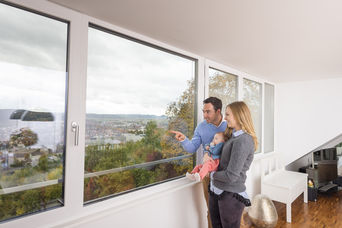Sealing windows properly
Drafts affect the comfort and well-being and generate expensive heat losses. In most cases, they are caused by leaks in the facade. One of the most critical areas is the space between window frame and masonry wall. If this area is not tightly sealed, residents will suffer from wintry conditions in their own four walls. They literally heat the outdoors instead of the living room. Here, the investment in sealing tapes and sealants pays off. And when choosing resident- and environmentally friendly products, you will not only prevent drafts and heat loss but also pollutants. Make sure to keep the following tips in mind.
1. Blower Door Test
The Blower Door Test is particularly well suited for detecting possible leaks. The test uses special equipment to create either a positive or negative pressure differential between inside and outside. This pressure difference forces air through holes and penetrations in the building shell and makes the leaks visible.
2. How to plug leaks
In order to keep cold drafts and noise outside, expert sealing is required to ensure a high degree of air and sound tightness. In accordance with the German Energy Saving Ordinance (EnEV), the following principle applies: “Inside tighter than outside”. Otherwise, the warm and humid room air will condense on the colder surfaces and result in moisture and mold damage. Thermal and sound insulation takes place in the middle insulation layer. The outer layer should be open to diffusion so that moisture can escape to the outside. It also protects against wind and rain. Depending on the materials used for window frames and walls, leaks can be plugged with gun-applied sealants such as silicone. Other gap fillers are cover strips, sealing tapes, foils/films and profiles in various shapes and sizes, for example made of rubber-like TPE (thermoplastic elastomer).
3. How to ventilate properly
No matter whether you dry clothes, take a shower, cook a meal or just breathe – all these activities produce moisture. Only proper ventilation of a well-insulated house can prevent the mold, which not only attacks the building fabric but also your health. The key to a perfectly insulated, draft-free home is therefore purge (or cross) ventilation: open the windows regularly and air the house briefly but intensely. Alternatively, a ventilation system can provide a regular flow of fresh air.
4. Use of healthy sealing products
Residents should look for healthy waterproofing and insulating products that have been granted the EMICODE® EC1 seal by GEV (Association for the Control of Emissions in Products for Flooring Installation, Adhesives and Building Materials). Otherwise, pollutants will remain in the house along with the heat. Products with the EC1 seal on the packaging meet the world’s strictest emission limits. They include sealing products for windows and facades, insulation panels and many other building and installation materials. The products are tested by independent laboratories using the test chamber method. To ensure long-term compliance with the limit values, regular spot checks are carried out by neutral experts and testing institutes.

©GEV
Share article on Social Media:
